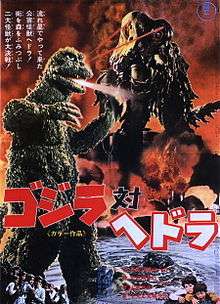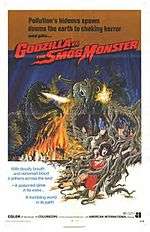Godzilla vs. Hedorah
| Godzilla vs. Hedorah | |
|---|---|
 Japanese theatrical release poster | |
| Directed by | Yoshimitsu Banno |
| Produced by | Tomoyuki Tanaka |
| Written by |
Yoshimitsu Banno Takeshi Kimura |
| Starring |
Akira Yamauchi Toshie Kimura Hiroyuki Kawase Keiko Mari Toshio Shiba |
| Music by | Riichiro Manabe |
| Cinematography | Yoichi Manoda |
| Edited by | Yoshitami Kuroiwa |
Production company | |
| Distributed by | Toho |
Release dates |
|
Running time | 85 minutes |
| Country | Japan |
| Language | Japanese |
| Budget | $250,000 (U.S)[1] |
Godzilla vs. Hedorah (ゴジラ対ヘドラ Gojira tai Hedora) is a 1971 Japanese science-fiction kaiju film produced by Toho. Directed by Yoshimitsu Banno and featuring special effects by Teruyoshi Nakano, the film stars Akira Yamauchi, Toshie Kimura, and Hiroyuki Kawase. The eleventh film in the Godzilla series, the film had a strong anti-pollution message, with director Banno being inspired after visiting a polluted beach near Yokkaichi.
The film marked director Banno's directorial debut; however, the budget for Godzilla vs. Hedorah was significantly lower than previous Godzilla films. Banno was only given 35 days to shoot the film and only had one team available to shoot both the drama and monster effects scenes. Veteran Godzilla director Ishirō Honda was later tasked by producer Tomoyuki Tanaka to watch Banno's rough cut and provide advice.[2]
The film was released theatrically in the United States in the spring of 1972 by American International Pictures as Godzilla vs. the Smog Monster.
Plot
The microscopic alien lifeform Hedorah feeds on Earth's pollution and grows into a poisonous, acid-secreting sea monster. After it sinks an oil tanker and attacks Dr. Toru Yano and his young son Ken Yano, scarring them both, Hedorah's toxic existence is revealed to the public. Ken Yano has visions of Godzilla fighting the world's pollution, and insists Godzilla will come to humankind's aid against Hedorah.
Hedorah metamorphoses into an amphibian form, allowing it to move onto land to feed on additional sources of pollution. Hedorah is confronted by Godzilla. Hedorah is easily overpowered by Godzilla and retreats into the sea. During the fight, however, several pieces of its new body are flung nearby, which then crawl back into the sea to grow anew and allow the monster to become even more powerful. It returns shortly thereafter in a flying saucer shape demonstrating new, even deadlier forms which it can switch between at will.
Thousands of people die in Hedorah's raids and even Godzilla is overwhelmed by Hedorah's poisonous emissions. As hope sinks, a party is thrown on Mt. Fuji to celebrate one last day of life before humankind succumbs to Hedorah. Ken Yano, Yukio Keuchi, Miki Fujiyama, and the other party-goers realize that Godzilla and Hedorah have come to Mt. Fuji as well for a final confrontation.
Dr. Toru Yano and his wife Toshie Yano has determined that drying out Hedorah's body may destroy the otherwise unkillable monster. The JSDF swiftly constructs two gigantic electrodes for this purpose, but their power is cut off by Godzilla and Hedorah's violent battle. Godzilla energizes the electrodes with its atomic ray, dehydrating Hedorah's outer body. Hedorah sheds this outer body and takes flight to escape, but Godzilla propels itself through the air with its atomic ray to give chase. Godzilla drags Hedorah back to the electrodes and continues to dehydrate it until Hedorah dies. Godzilla tears apart Hedorah's dried-out body and dehydrates the pieces until nothing remains but dust.
With Ken Yano calling after him, Godzilla returns to the sea, but not before glaring threateningly at the surviving humanity whose pollution spawned Hedorah.
Cast
- Akira Yamauchi as Dr. Toru Yano (矢野 徹 Yano Toru)
- Hiroyuki Kawase as Ken Yano (矢野 研 Yano Ken)
- Keiko Mari as Miki Fujinomiya (富士宮 ミキ Fujinomiya Miki)
- Toshio Shiba as Yukio Keuchi (毛内 行夫 Keuchi Yukio)
- Toshie Kimura as Toshie Yano (矢野 敏江 Yano Toshie)
- Yoshio Yoshida as Gohei, a fisherman
- Haruo Suzuki as JSDF Officer
- Yoshio Katsube as JSDF Engineer
- Haruo Nakajima as Godzilla
- Kenpachiro Satsuma as Hedorah
Production

Director Banno initially conceived the idea for Godzilla vs. Hedorah after seeing cities like Yokkaichi covered in black smog and the ocean filled with foam from dumped detergent and formulated the story of an alien tadpole transforming into a monster as a result of the pollution.[3]
Hedorah's origin is also unique for it is the only monster to be created from pollution. This was the first Godzilla film in several years to neither reuse an old monster (not counting Godzilla) or recycle footage from a previous movie in the series. This is noteworthy since the previous five films (made between 1965-1969) had increasingly done both. This film has the only occurrence of Godzilla flying under his own power. He uses his atomic ray as jet propulsion. Director Banno reportedly added the scene to provide a light moment in what is otherwise a fairly dark film compared to many of those which preceded it.
Kenpachiro Satsuma, the actor who played Hedorah, was struck with appendicitis during the production. Doctors were forced to perform the appendectomy while he was still wearing the Hedorah suit, due to the length of time it took to take off. During the operation, Satsuma learned that painkillers have no effect on him.[4]
Release
Box office
In Japan, the film sold 1,740,687 tickets.
English versions

The film was released in April 1972 by American International Pictures under the title Godzilla vs. the Smog Monster. There were several small alterations: dialogue was dubbed into English by Titan Productions,[5] several shots with Japanese text were replaced with English or textless equivalents, additional sound effects and foley were added to some scenes, and the song "Save the Earth" (based on a song in the original Japanese version of the film) was added. This version was rated 'G' by the MPAA, and the same version was given an 'A' certificate by the BBFC for its UK theatrical release in 1975.[6]
The AIP version has been replaced in the North American home video and television markets (including Sony's DVD) by Toho's international version, titled Godzilla vs. Hedorah. This version features the original English dub produced in Hong Kong, and by extension lacks the English-language song, Save the Earth. This version was first broadcast in the United States by the Sci-Fi Channel, on January 20, 1996.[7]
Critical reception
Critical reaction to the film has been mixed, with some embracing its eccentricity and others deriding it.
Japan Hero said the film is "recommended for Godzilla fans, but don't expect much out of it," adding that while "the special effects appear to be pretty good" and "watching it in its original [Japanese] language does make the movie more tolerable," "the character designs ... are bad" and "the music ... really kills the movie."[8] Monster Zero criticized the film's production values and said that it "succeeds in carrying the series over the edge into strictly kid's stuff" and "begins the series' inexorable slide into oblivion."[9] Stomp Tokyo said the film has "many obvious, crippling flaws" but added that "there are some good things," praising the monster action in particular.[10] In a review of Godzilla 1985, Roger Ebert cited it as his favorite of the Godzilla movies.[11]
American Kaiju called the film "a confused Godzilla non-epic that doesn't seem to be sure just who it was made for in the first place."[12] DVD Talk said it "earns points for trying something new, to break away from what was fast becoming a tired formula. The film isn't as entertaining as Godzilla vs. Gigan or Godzilla vs. Mechagodzilla, but it is more original and daring, and ... fans will want to pick [it] up."[13]
The U.S. dubbed version was featured in the 1978 book The Fifty Worst Films of All Time.[14]
Home media
The film was released on VHS by Orion Pictures in 1989, and on DVD by Sony Pictures Home Entertainment on October 19, 2004. The film received a Blu-ray release by Kraken Releasing on May 6, 2014.[15]
Legacy
After director Yoshimitsu Banno finished directing Godzilla vs. Hedorah, he began work on creating another installment in the Godzilla series. Like his first Godzilla movie, Banno had wanted the next film to have a strong message against pollution. The initial idea was that a mutant starfish-like monster battles Godzilla. However, he scrapped this idea and wrote what was going to be Godzilla vs. Hedorah 2. In it, Godzilla was to fight another Hedorah, this time in Africa. Due to Tomoyuki Tanaka's reaction to Banno's first Godzilla film, this was never realized.
Banno spent several years trying to acquire funding for a 40-minute IMAX 3D Godzilla film starring a new version of Hedorah called Deathla. The project was tentatively titled Godzilla 3D: To The Max. The project was eventually scrapped but several members of the production team, including Banno, would work on the 2014 Godzilla. In November 2013, Banno stated that he still hoped to make a sequel to Godzilla vs. Hedorah.[16]
Cancelled sequel
Yoshimitsu Banno was so pleased with Godzilla vs. Hedorah that he started writing another Godzilla film. Banno began preparing a script for Godzilla vs. Hedorah 2. However, Tomoyuki Tanaka, who was hospitalized during the production of Godzilla vs. Hedorah was extremely dissatisfied with the final product and went as far as to tell Banno that he had "ruined Godzilla." Tanaka prevented Banno from directing another Toho film afterwards, and demoted him from director to producer on several upcoming films.
According to Banno though, from later interviews conducted with him, Godzilla vs. Hedorah 2 was actually still being worked on after he was removed from the project. Although who the new director would have been is unknown, but Jun Fukuda seems the most likely candidate considering that he would step up to direct the next three Godzilla films. If the film was going to keep its Africa setting at this stage is not known. The project was eventually scrapped, and three more proposed projects would be introduced that following year before finally settling on Godzilla vs Gigan (1972). In 2014, in an interview with Banno, he had stated that he read a Godzilla film history book from the US and that he was surprised to read that the next film would take place in Africa and that Tanaka had said that he had banned him from his director position, thus conclusively proving these rumours to be false.
A single remnant of Banno's intentions to produce a sequel exists in the finished film. At the end of the film, an illustration of Hedorah's tadpole form can be seen, followed by a black screen with red text stating "And another one?", implying that the director had already prepared a sequel for approval.
References
- ↑ http://www.tohokingdom.com/box_office/godzilla_vs_hedorah.htm
- ↑ "Smog Monster Director". Scifi Japan TV. September 4, 2014.
- ↑ "Smog Monster Director EXTRA". Scifi Japan. September 11, 2014.
- ↑ Guy Marriner Tucker, Age of the Gods.
- ↑ "Godzilla vs. the Smog Monster (Image Entertainment laserdisc)".
- ↑ http://www.bbfc.co.uk/releases/godzilla-vs-smog-monster-1970
- ↑ http://www.innermind.com/sfc/lists/sfc9601.htm
- ↑ Review Japan Hero
- ↑ Review Monster Zero
- ↑ Review Stomp Tokyo
- ↑
- ↑ Review American Kaiju
- ↑ Review DVD Talk
- ↑ Big Empire
- ↑ "Godzilla vs. the Smog Monster Blu-ray". Blu-ray.com. Retrieved 16 November 2016.
- ↑ McGloin, Matt (November 26, 2013). "Hedorah Confirmed For Godzilla 2014 Movie & Smog Monster Sequel?!". Cosmic Book News. Retrieved February 6, 2014.
External links
| Wikiquote has quotations related to: Godzilla vs. Hedorah |
- Godzilla on the web (Japan)
- Godzilla vs. Hedorah at the Internet Movie Database
- Godzilla vs. Hedorah at AllMovie
- Godzilla vs. Hedorah at Rotten Tomatoes
- "ゴジラ対ヘドラ (Gojira tai Hedora)" (in Japanese). Japanese Movie Database. Retrieved 2007-07-18.